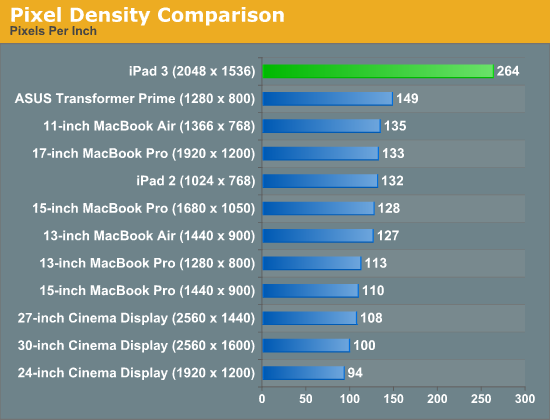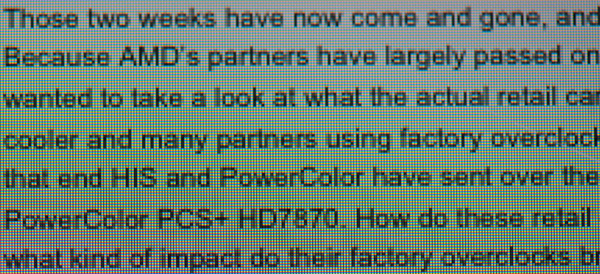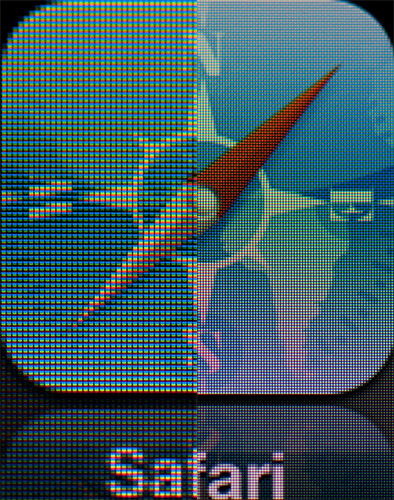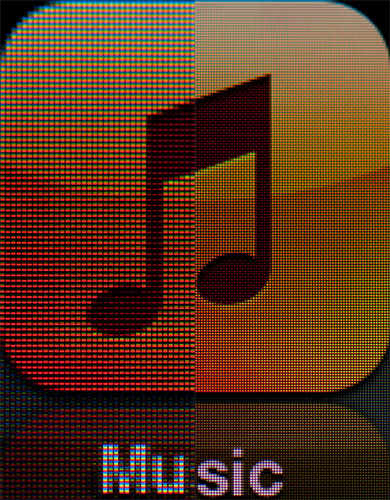The new iPad: Retina Display Analysis
by Anand Lal Shimpi on March 19, 2012 5:49 PM ESTWe're hard at work on our review on the new iPad but with a fair bit of display analysis under our belts I thought a quick post might be in order. One of the major features of the new iPad is its 2048 x 1536 Retina Display. Apple kept the dimensions of the display the same as the previous two iPad models, but doubled the horizontal and vertical resolution resulting in a 4x increase in pixels. As display size remained unchanged, pixel density went through the roof:

Although the iPad 2 has a fairly high pixel density compared to most of Apple's Mac/display lineup, you're more likely to hold a tablet closer to your eyes which made the low resolution/pixel density problematic. The new iPad addresses this issue as you can see from the chart above. I can't focus closely enough to the panel to actually make out pixels on the new iPad, much less at a normal viewing distance. With the aid of a macro lens we can definitely identify individual pixels. The improvement over the iPad 2 display is striking:
To the left we have the original 1024 x 768 panel, and to the right we have the new Retina Display. At this distance you can still identify individual pixels, an ability that quickly vanishes at normal viewing distances. The Music app icon is an even better example of what you gain from the newer display as it has more high contrast edges that appear more aliased on the 1024 x 768 panel:
The old iPad's 1024 x 768 resolution was fairly bothersome when it came to reading text on web pages or books. Most Android tablets standardizing on 1280 x 800 offered an advantage in that respect, albeit not delivering significantly higher pixel density. The new iPad completely resolves this issue. Hover over the links below to see roughly the same paragraph of text from our retail Radeon HD 7870 review on the iPad 2, new iPad and ASUS Transformer Prime:

| Apple iPad 2 | Apple iPad (3rd gen) | ASUS TF Prime |
| original | original | original |
While it's still obvious that you're looking at a screen and not an e-ink display, the pixels perform a good disappearing act on the new iPad.












172 Comments
View All Comments
name99 - Tuesday, March 20, 2012 - link
I hate to have to point out the obvious but you've said something REALLY stupid here.PDFs are not "terrible" on iPads. It's just that iBooks is a crappy PDF reader.
Go to the App Store. Type in PDF Reader. You will see a hundred different possibilities, pretty much all of which allow you to crop PDFs. Personally I think GoodReader is the best because of its various synchronization abilities and its hierarchical filing system, but there are plenty of alternatives and even the free options are not too bad.
svojoe - Tuesday, March 20, 2012 - link
I'm really happy to see pixel densities increasing. But really this is not revolutionary... my 4 year old HTC FUZE smart phone had a 2.8" screen, and a 640x480 resolution. I think that is 288PPI.Which would mean, its pixel density is 'higher' than the IP3. Its not as if this is 'amazing' innovation to me. However its nice because I've been thoroughly saddened by pixel counts dropping for the last 6 years.
name99 - Tuesday, March 20, 2012 - link
(a) No-one is calling it revolutionary. They are calling it a really nice screen for a tablet.(b) It's a TABLET-SIZED screen, not a 2.8" screen. The fact that people could make SMALLER high-res screens years ago is not a secret.
You're acting like someone who sees that you can now buy a thin LCD 46" TV for $500 and says "So what, we had color TVs thirty years. Admittedly they cost a fortune, and had a smaller screen, and weighed a ton, and were three feet deep, but they displayed TV and that's all that really matters".
svojoe - Wednesday, March 21, 2012 - link
Maybe you have not caught some of the hype over the ip3. I've heard people call the new screen "a huge leap forward", "magical clarity", etc etc. Maybe I am a bit put off by all this hoop-la. I haven't even seen one yet, but I'm sure its really amazing levels of detail. And that is good. In this instance I want to applaud apple for raising the bar. Because it has falling oh, so low the last several years when it comes to resolution and PPI.Taurus229 - Tuesday, March 20, 2012 - link
Brightness is OK, pixel count makes it shine !!!!!!! Goodbye Metro and Windows 8 !!!!!!!! Maybe now, Microsoft won't put all their eggs in one basket, and ignore corporate and desktop users.ffletchs - Tuesday, March 20, 2012 - link
you left out the best tablet display yet, Samsung Galaxy Tab 7.7, the only tablet with Super AMOLED+ displaytrane - Wednesday, March 21, 2012 - link
In my opinion, the pixels per inch doesn't count for anything until you account for viewing distance.Consider iPhone and iPad, they call it a Retina display despite a lower PPI versus iPhone simply because people are looking at their tablets from further away than their phones.
The iPad may have a 2.5x higher PPI than the 30 inch display, but you are looking at your iPad from 12-18 inches away, while a 30 inch display will need a 4-5 feet viewing distance. The iPad will certainly be 2.5x sharper than the 30 inch Cinema Display at the same viewing distance, but who looks at a 30 inch display from 1 feet out?! In fact, most people watch 32 inch HDTVs from as far as 10 feet away. So viewing distance must be accounted for.
rakez - Wednesday, March 21, 2012 - link
sorry i still prefer widescreen. yes, even for my tablets.Lucian Armasu - Wednesday, March 21, 2012 - link
It seems the new Galaxy Tab 7.7 with a 5,100 kills the new iPad in battery efficiency, even though it has a more than twice as big battery at ~12,000 mAh. And it still manages to get around 200 PPI but on a Super AMOLED Plus display, which is preferable to any IPS display in my opinion.doobydoo - Thursday, March 22, 2012 - link
It has a far smaller screen, much lower resolution, massively inferior GPU. It's no surprise that it can last longer. The 200 PPI is less useful given that typical users will hold it closer than the larger ~10 inch tablets.It's also more expensive than the new iPad in the UK.